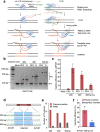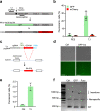Template-jumping prime editing enables large insertion and exon rewriting in vivo
- PMID: 37291100
- PMCID: PMC10250319
- DOI: 10.1038/s41467-023-39137-6
Template-jumping prime editing enables large insertion and exon rewriting in vivo
Abstract
Targeted insertion of large DNA fragments holds promise for genome engineering and gene therapy. Prime editing (PE) effectively inserts short (<50 bp) sequences. Employing paired prime editing guide RNAs (pegRNAs) has enabled PE to better mediate relatively large insertions in vitro, but the efficiency of larger insertions (>400 bp) remains low and in vivo application has not been demonstrated. Inspired by the efficient genomic insertion mechanism of retrotransposons, we develop a template-jumping (TJ) PE approach for the insertion of large DNA fragments using a single pegRNA. TJ-pegRNA harbors the insertion sequence as well as two primer binding sites (PBSs), with one PBS matching a nicking sgRNA site. TJ-PE precisely inserts 200 bp and 500 bp fragments with up to 50.5 and 11.4% efficiency, respectively, and enables GFP (~800 bp) insertion and expression in cells. We transcribe split circular TJ-petRNA in vitro via a permuted group I catalytic intron for non-viral delivery in cells. Finally, we demonstrate that TJ-PE can rewrite an exon in the liver of tyrosinemia I mice to reverse the disease phenotype. TJ-PE has the potential to insert large DNA fragments without double-stranded DNA breaks and facilitate mutation hotspot exon rewriting in vivo.
© 2023. The Author(s).
Conflict of interest statement
E.J.S. is a co-founder and Scientific Advisory Board member of Intellia Therapeutics and a Scientific Advisory Board member at Tessera Therapeutics. The University of Massachusetts Chan Medical School has filed a patent application on TJ-PE in this work (inventors: C.Z., B.L., X.D., E.J.S. and W.X, patent filed/pending). The remaining authors declare no competing interests.
Figures





Similar articles
-
A split prime editor with untethered reverse transcriptase and circular RNA template.Nat Biotechnol. 2022 Sep;40(9):1388-1393. doi: 10.1038/s41587-022-01255-9. Epub 2022 Apr 4. Nat Biotechnol. 2022. PMID: 35379962
-
An optimized prime editing system for efficient modification of the pig genome.Sci China Life Sci. 2023 Dec;66(12):2851-2861. doi: 10.1007/s11427-022-2334-y. Epub 2023 Jul 25. Sci China Life Sci. 2023. PMID: 37505431
-
Improved prime editors enable pathogenic allele correction and cancer modelling in adult mice.Nat Commun. 2021 Apr 9;12(1):2121. doi: 10.1038/s41467-021-22295-w. Nat Commun. 2021. PMID: 33837189 Free PMC article.
-
Prime editing: current advances and therapeutic opportunities in human diseases.Sci Bull (Beijing). 2023 Dec 30;68(24):3278-3291. doi: 10.1016/j.scib.2023.11.015. Epub 2023 Nov 7. Sci Bull (Beijing). 2023. PMID: 37973465 Review.
-
Evolution of Prime Editing Systems: Move Forward to the Treatment of Hereditary Diseases.Curr Gene Ther. 2025;25(1):46-61. doi: 10.2174/0115665232295117240405070809. Curr Gene Ther. 2025. PMID: 38623982 Review.
Cited by
-
In Vivo Prime Editing by Lipid Nanoparticle Co-delivery of Chemically Modified pegRNA and Prime Editor mRNA.GEN Biotechnol. 2023 Dec;2(6):490-502. doi: 10.1089/genbio.2023.0045. Epub 2023 Dec 15. GEN Biotechnol. 2023. PMID: 39850578 Free PMC article.
-
EXPERT expands prime editing efficiency and range of large fragment edits.Nat Commun. 2025 Feb 13;16(1):1592. doi: 10.1038/s41467-025-56734-9. Nat Commun. 2025. PMID: 39939583 Free PMC article.
-
Recent advances in prime editing technologies and their promises for therapeutic applications.Curr Opin Biotechnol. 2024 Apr;86:103071. doi: 10.1016/j.copbio.2024.103071. Epub 2024 Feb 7. Curr Opin Biotechnol. 2024. PMID: 38330875 Free PMC article. Review.
-
CRISPR-Enabled Autonomous Transposable Element (CREATE) for RNA-based gene editing and delivery.EMBO Rep. 2025 Feb;26(4):1062-1083. doi: 10.1038/s44319-024-00364-7. Epub 2025 Jan 9. EMBO Rep. 2025. PMID: 39789389 Free PMC article.
-
Click editing enables programmable genome writing using DNA polymerases and HUH endonucleases.Nat Biotechnol. 2025 Jun;43(6):923-935. doi: 10.1038/s41587-024-02324-x. Epub 2024 Jul 22. Nat Biotechnol. 2025. PMID: 39039307 Free PMC article.
References
Publication types
MeSH terms
Substances
Grants and funding
LinkOut - more resources
Full Text Sources
Other Literature Sources

